<p><br> <span class="small">July 24, 2025</span></p>
Consumers adopting AI will reshape the energy and utilities customer journey
<p><b>Our AI Inclination Index reveals which consumers are most open to using AI in the energy and utilities journey—as well as where and how they’ll use it. These insights can empower companies to develop a nuanced, effective consumer-facing AI strategy.</b></p>
<p>When it comes to efficiently and sustainably procuring utilities for their home or keeping their cars fueled or charged, the average consumer may feel a distinct lack of empowerment. With little control over heating, cooling, electricity or gas prices, many consumers might wonder what actions they can take to lower their carbon footprint and monthly energy bills.</p> <p>Artificial intelligence could go a long way toward changing that power dynamic. Increasingly sophisticated consumer AI tools could enable consumers to make more informed decisions about their power consumption through factual and detailed usage information, whether it’s managing their home heating and cooling systems based on their daily schedule or analyzing their driving behavior to suggest fuel-saving habits.</p> <p>However, consumers’ growing use of AI poses a distinct challenge for energy and utility companies aiming to engage customers on their terms and capitalize wisely on the opportunity. Companies in these sectors need to determine which individuals are most (and least) inclined to use AI, their preferred tools and where AI integration would be most suitable.</p> <p>Our recent research uncovered some surprising insights into those challenges. Using data from <a href="https://www.cognizant.com/us/en/aem-i/new-minds-new-markets-ai-customer-experience" target="_blank" rel="noopener noreferrer">our consumer AI study</a>, we developed the AI Inclination Index, which quantifies consumers’ propensity to use AI (see explainer box below). The index reveals that consumers are slightly more inclined to use AI in energy and utilities than in other industries (see Figure 1); however, that broad finding masks important variations.</p> <p>Consumer attitudes toward AI differ significantly depending on whether they’re learning about, buying or using products and services. Attitudes also vary across the four energy and utilities product categories in our study. These categories include: </p> <ul> <li>Utilities (gas, electric, water)</li> <li>Energy-saving devices (smart thermostats, light switches, plugs)</li> <li>Vehicle fuel (fuel usage monitoring, driving behavior analytics)</li> <li>Electric vehicle charging (charging stations, optimal charging time thresholds)</li> </ul> <p><b>Consider these metrics about AI adoption in the energy and utilities sector:</b></p> <ul> <li><b>Utilities and energy-saving devices are key drivers of AI interest.</b> Consumer interest in AI for these product categories is particularly high in the Learn phase, where they achieve a nearly perfect AI Inclination Index score. Meanwhile, vehicle fuel and charging show less AI inclination throughout the purchase journey.<br> <br> </li> <li><b>Younger and high-income consumers are the biggest AI enthusiasts.</b> In line with <a href="https://www.cognizant.com/us/en/aem-i/new-minds-new-markets-ai-customer-experience" target="_blank">our cross-industry report</a>, younger (and presumably more tech-savvy) consumers show the most enthusiasm for using AI tools when learning about, buying and using energy and utilities goods and services. Consumers with high incomes, meanwhile, are significantly more interested in using AI than those in lower-income brackets.<br> <br> </li> <li><b>Conversational AI is the overwhelming tool of choice </b>across all product categories and phases in the purchase journey. The tool’s aptitude for providing personalized responses based on individual preferences proves beneficial in a variety of capacities, from comparing options for energy providers, to suggesting efficient energy usage strategies based on the consumer’s exact parameters.</li> </ul> <p><b>The AI Inclination Index</b></p> <p><i>To quantify consumers' propensity to adopt AI-driven technology features throughout the consumer journey, we developed the AI Inclination Index. The index was calculated using three measures from our “New minds, new markets” survey data.</i></p>
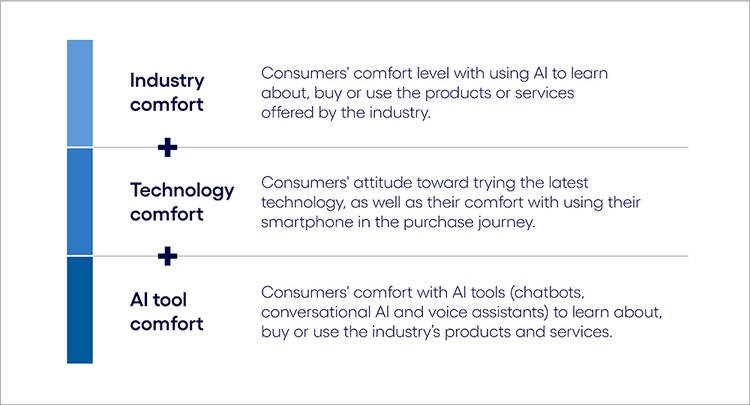
#
<p> </p> <p><b>AI inclination in energy and utilities vs. the global average</b></p> <p><i>Consumers are more inclined to use AI when purchasing energy and utilities products and services than other industries’ goods.</i></p>
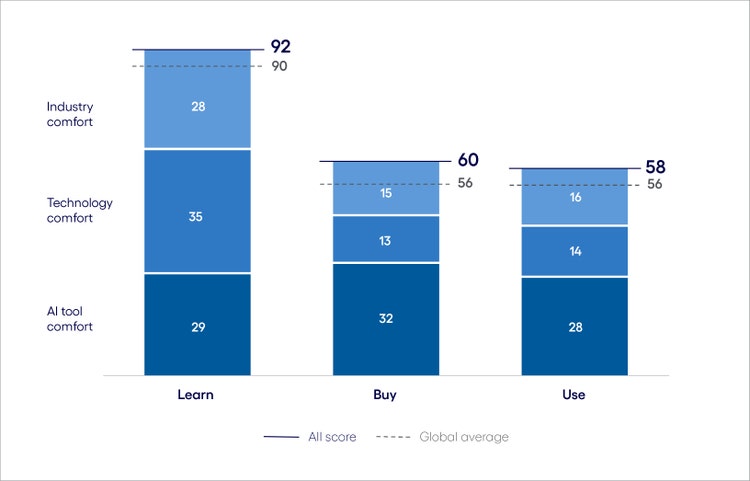
#
<p><span class="small">Figure 1 <br> Base: 8,451 respondents in the US, UK, Germany and Australia <br> Source: Cognizant Research</span></p>
<p>With these variances, it’s clear energy and utility providers will need to craft a highly precise and nuanced AI strategy that captures the greatest areas of opportunity while avoiding low-value pursuits.</p> <p>Understanding consumer use of AI, as well as the accompanying pockets of spending power, is essential for leaders in all industries. In our global study <a href="https://www.cognizant.com/us/en/new-minds-new-markets-ai-customer-experience" target="_blank">New minds, new markets</a>, we found that consumers who are enthusiastic about using AI will account for up to 55% of all spending made across industries. This amounts to $4.4 trillion in spending in the US alone and from $540 billion to $690 billion in Germany, Australia and the UK.</p> <p>In this report, energy and utility providers will learn about where in the purchase journey consumers are most and least inclined to use AI, the AI tools they would be most apt to use and how this differs among consumers across age groups. With this information, businesses can reshape their approach to customer engagement—where and how it matters most. </p>
<h4>AI across the energy and utilities journey<b></b></h4> <p>As our AI Inclination Index indicates, consumers are more likely than the global average to use AI across all three stages of the energy and utilities consumer journey—Learn, Buy and Use. In the Buy phase, index scores are about 7% higher than the global average.</p> <p>But a closer analysis reveals the different dynamics at play between the purchase phases and product categories in our study.</p> <p>For example, the Learn phase shows the highest AI index scores across all product categories. Energy-saving devices lead the way, followed closely by utilities, while vehicle fuel and charging trail behind. Similar to our cross-industry report, AI interest drops in the Buy phase when it comes to AI-automated purchasing. In particular, technology comfort scores nosedive in this phase by nearly 65% across all product areas.</p> <p>In the Use phase, the scores show a further decline from the Buy phase. Here, index scores for vehicle fuel and electric charging are below those of utilities and energy-saving devices.</p> <p>These variances are important to keep in mind as we review how consumers feel about using AI across all purchase stages of the energy and utilities industry.</p>
About our analysis
To understand consumer AI behaviors and attitudes at a granular level, we structured our analysis around four key pillars:
- The consumer journey. We studied the specifics of AI use at each phase of the customer journey. This journey—how consumers discover, purchase and engage with products and services before and after a sale—is at the heart of the business-customer relationship.
- Consumer demographics. To gain a better understanding of how consumer attitudes and behaviors differ by age group, we divided consumers into five categories: 18–24, 25–34, 35–44, 45–54 and 55+.
- Consumer AI tools. We defined consumer AI use by asking about their intended use of three key tools that are prevalent in the consumer world: voice assistants, chatbots and conversational AI.
- Industry-specific products. We included four energy and utilities categories in our analysis: utilities, energy-saving devices, vehicle fuel and electric vehicle charging.
<h5><b>The Learn phase: The pursuit of savings and efficiency drive near-perfect AI index scores</b></h5> <ul> <li><span class="eds-label">Consumer AI interest is highest in energy-saving devices and utilities</span></li> </ul> <ul> <li><span class="eds-label">High-income energy and utilities consumers are the most likely group to use AI in this phase</span></li> </ul> <ul> <li><span class="eds-label">Conversational AI rules supreme</span></li> </ul> <p>The discovery phase is where consumers are most inclined to use AI-enabled tools in the energy and utilities industry. The AI Inclination Index score for the Learn phase is 33 points higher than in the Buy phase. Among the four product categories, vehicle charging is the furthest below the global average (see Figure 2).</p> <p>This is the stage when consumers are researching things like the best energy monitoring devices or smart energy plugs, or optimal routes for charging an electric vehicle (EV). Whether they’re searching for new energy and utility products and services or enhancing the ones they already have, AI tools can play a role in helping consumers feel more in control of their carbon footprint.</p> <p>As such, the Learn phase represents a prime opportunity for businesses to capture attention and influence decisions. Doing so starts with understanding what consumers value about using AI in this phase and the AI tools they’re most apt to use.</p> <p><b>Energy and utilities AI Inclination Index: The Learn phase</b></p>
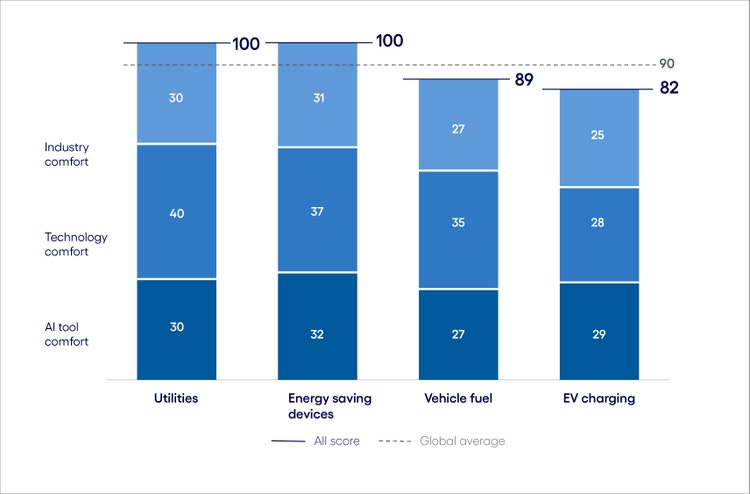
#
<p><span class="small">Figure 2<br> Base: 8,451 respondents in the US, UK, Germany and Australia<br> Source: Cognizant Research</span></p>
<p><b>Consumer AI interest is highest in energy-saving devices and utilities</b></p> <p>With <a href="https://institute.bankofamerica.com/content/dam/economic-insights/utilities-update.pdf" target="_blank" rel="noopener noreferrer">median utility bill payments up by 6%</a> in the US—well above the rate of inflation this past January—it’s easy to see why consumers would welcome new ways to lower their energy bills. When it comes to comparing options for energy providers, smart water heaters, thermostats and window shades, many understand the value of AI in helping them sift through the noise and select the right choice for their home.</p> <p>The option to change providers varies regionally, but in places like the US, UK, Portugal and many countries in Europe, AI has the power to help consumers navigate the variety of energy and utility options available. As one consumer said, “Given the dynamic nature of the sector, AI could signal when it’s time to switch providers or service package, based on cost and other important factors.” This is especially true in the UK, <a href="https://www.simon-kucher.com/en/insights/energy-study-2022-customers-increasingly-willing-switch-gas-and-electricity-providers" target="_blank" rel="noopener noreferrer">where 35% of consumers are willing to switch providers</a>, nearly 10 points higher than the European average.</p> <p><b>High-income energy and utilities consumers are the most likely group to use AI in this phase</b></p> <p>High-income consumers ($80,000+) are significantly more inclined than those with lower incomes ($40,000 or lower) to use AI and digital technologies, such as their mobile phones, to learn about energy and utilities products. This is consistent across all consumer age groups.</p> <p>Consider this dramatic example: Among low-income consumers, the index score for the younger crowd (18–24) exceeds that of the oldest cohort (55+) by 13 points. Shift to the high-income bracket, and the score distinction simply vanishes—that's right, the senior set is just as likely as the college kids to embrace AI for energy and utilities.</p> <p>The reason for this is likely based on home ownership. Consumers aged 55+ are more likely than younger consumers to own homes and pay energy bills. According to some estimates, <a href="https://housecashin.com/knowledge-base/home-ownership-statistics/#:\~:text=Those%20between%2055%2D64%20own,is%20skewed%20towards%20older%20generations." target="_blank" rel="noopener noreferrer">75%</a> of consumers 55 and over currently own their own home, nearly double the rate of those 35 and under.</p> <p>Meanwhile, younger high-income consumers are more likely to own homes than their lower-income counterparts due to their increased spending power. They’re also more likely to be able to afford a smart home, as these can cost <a href="https://www.vivint.com/resources/article/smart-homes-2025" target="_blank" rel="noopener noreferrer">double</a> that of a traditional home. While this price difference is stark, <a href="https://www.vivint.com/resources/article/smart-homes-2025" target="_blank" rel="noopener noreferrer">one in four</a> believe in five years’ time, smart homes will be the new standard, leaving the benefits of these technologies to those who have the means.</p> <p><b>Conversational AI rules supreme</b></p> <p>Conversational AI is the overwhelming tool of choice across all age groups and in all four product categories. By leveraging natural language processing and machine learning algorithms, conversational AI can provide personalized recommendations on energy providers and smart home devices based on a consumer's preferences, budget, lifestyle and usage data.</p> <p>For example, <a href="https://www.anaconda.com/blog/anaconda-launches-lumen-ai" target="_blank" rel="noopener noreferrer">Lumen AI</a> demonstrates how conversational AI can transform energy and utility questions into answers. Consumers can upload raw energy data into the tool to gain insights into their personal usage or broader consumption trends throughout the national energy landscape.</p>
<h5><b>The Buy phase: Consumer interest in AI declines but remains above the global average</b></h5> <ul> <li><span class="eds-label"><a><b>Younger energy and utilities consumers show nearly three times as much interest in AI as older consumers</b></a></span></li> </ul> <ul> <li><span class="eds-label"><b>EV charging is the only product category to fall below the global average</b></span></li> </ul> <ul> <li><span class="eds-label"><b>AI interest is higher for digital voice assistants and chatbots than at any other stage</b></span></li> </ul> <p>Scores in some components of the AI Inclination Index are much lower in Buy than in Learn, especially the technology comfort component, which drops 22 points. This decline represents consumers' hesitancy to use digital technologies such as smartphones for the final purchase transaction. The reluctance may be tied to the costs at stake; while some energy and utilities purchases can be small, like household energy-saving devices, they can also come with a much higher price tag, such as installing an EV charging station. The combination of using newer technologies and making payments via smartphones vs. a personal computer gives consumers pause.</p> <p>Industry comfort also decreases 13 points<b>,</b> suggesting a level of distrust toward AI tools provided directly by energy and utilities companies themselves. This highlights a disconnect between comfort with using third-party tools vs. tools offered by energy and utilities companies. It also reveals a deeper concern about who ultimately benefits from these technologies.</p> <p>With this in mind, AI tool comfort scores are three points higher in Buy vs. Learn. This suggests a preference by consumers in using more generalized, well-established AI tools for purchasing products and services, especially when they feel this transaction is neutral and no single party would stand to benefit disproportionately.</p> <p>As with the Learn phase, attitudes differ across consumer age groups and product categories.</p> <p><b>Energy and utilities AI Inclination Index: The Buy phase</b></p>
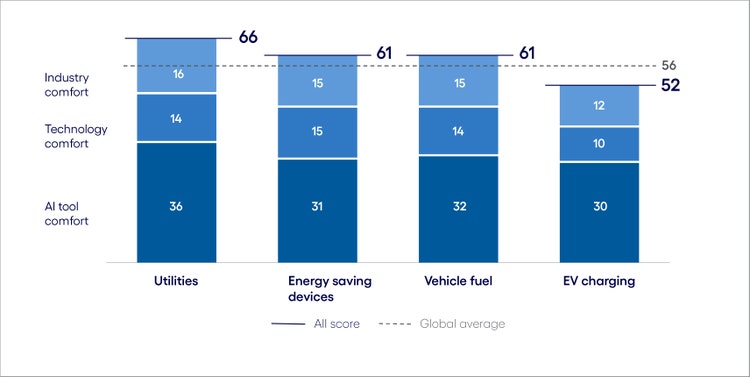
#
<p><span class="small">Figure 3<br> Base: 8,451 respondents in the US, UK, Germany and Australia<br> Source: Cognizant Research </span></p> <p><b>Younger energy and utilities consumers show nearly three times as much interest in AI as older consumers</b></p> <p>Younger consumers (18–34) are almost three times as likely to use AI to buy energy and utilities products and services as the 55+ cohort. <a href="https://www.wjbf.com/business/press-releases/ein-presswire/811839880/nearly-half-of-u-s-homes-have-smart-devices-higher-among-younger-and-multicultural-consumers-new-horowitz-study-finds/#:\~:text=For%20instance%2C%20younger%20consumers%20%E2%80%93%2059,50%2B%20year%2Dolds)." target="_blank" rel="noopener noreferrer">Research</a> has consistently shown younger consumers are willing to pay more for a home or apartment that features smart home tech—and that trend will gain momentum as younger consumers reach their peak spending power.</p> <p>In addition to higher interest in smart home tech, younger consumers’ <a href="https://www.solarreviews.com/blog/gen-z-future-of-home-solar-industry" target="_blank" rel="noopener noreferrer">preferences</a> for renewable energy are encouraging energy and utilities companies to offer more diverse home energy packages. For example, Pacific Gas and Electric Company (PG&E) now offers time-of-use, tiered rate and solar rate plans for consumers looking to lower their home’s carbon footprint. These plan rollouts are relatively more recent additions to their customer-facing offerings, with even more significant changes in recent years.</p> <p><b>EV charging is the only product category to fall below the global average</b></p> <p>EV charging falls 14 points lower on the index during the Buy phase than the global average. However, high-income consumers show an upswing of more than 20 points when compared with low- and medium-income consumers for this product category. This is likely due to the high cost of purchasing and installing EV charging stations in one's home and to the fact that as of now, EVs are significantly pricier than comparable internal combustion cars and trucks.</p> <p>While EVs often come with Level 1 wall plug-in chargers, they take <a href="https://www.motorbiscuit.com/long-take-charge-plug-in-hybrid-electric-vehicle-phev-level-1-charging/" target="_blank" rel="noopener noreferrer">up to two days</a> to fully charge via this low-level capacity. As <a href="https://www.canarymedia.com/articles/ev-charging/5-charts-that-shed-new-light-on-how-people-charge-evs-at-home" target="_blank" rel="noopener noreferrer">studies show</a>, most consumers prefer to charge their EV at home or work, where long charge periods can occur. A good EV home charger <a href="https://www.motortrend.com/features/home-ev-charging-installation-guide" target="_blank" rel="noopener noreferrer">runs between</a> $350 and $750, with installation costs ranging from $800 to $2,000. This pricing is affected by charger, connection, brand, location, labor and, most importantly, permits. Given all the costs and complexity, it is clear why consumers may hesitate to allow AI to make such a considerable decision on their behalf.</p> <p><b>AI interest is higher for digital voice assistants and chatbots than at any other stage</b></p> <p>While conversational AI remains the preferred tool, digital voice assistants and chatbots have their strongest showing in the Buy phase. At just 4 points below conversational AI, the gap is much narrower than in the Learn and Use phases. This showcases consumers’ broad interest in low-friction tools when it comes to making energy and utility purchases in a way that saves them money.</p> <p>After all, utilities make up nearly <a href="https://www.forbes.com/home-improvement/living/monthly-utility-costs-by-state/" target="_blank" rel="noopener noreferrer">10%</a> of consumers’ annual income, and a further <a href="https://www.lookupaplate.com/blog/heres-how-much-the-average-american-spends-on-gas-a-month/" target="_blank" rel="noopener noreferrer">3%</a> goes to fueling up their cars. With the incorporation of AI into homes through such items as smart thermostats, smart bulbs and switches, plugs and curtains, savings can range from <a href="https://blog.switch-bot.com/how-much-money-can-you-save-with-a-smart-home/" target="_blank" rel="noopener noreferrer">10%–30%.</a></p> <p>Many of these functionalities can be commanded through a connected voice assistant system; additionally, the associated energy and utility bills these AI-driven tools are tied to could be paid through a single voice command. In addition, trained chatbots can offer efficient energy and utility payment processing and support options.</p>
<h5><b>The Use phase: Consumers are unexpectedly reserved in AI adoption at the post-purchase stage</b></h5> <ul> <li><span class="eds-label"><b>Consumer interest in AI is lowest for vehicle fuel</b></span></li> </ul> <ul> <li><span class="eds-label"><b>Privacy concerns counterbalance comfort with technology</b></span></li> </ul> <ul> <li><span class="eds-label"><b>Older energy and utilities consumers show the lowest AI inclination</b></span></li> </ul> <p>AI interest in the Use phase largely mirrors that of the Buy phase. With the exception of vehicle fuel and EV charging—which drops 11 points from Buy—the remaining categories exceed the global average.</p> <p>At the same time, the dip in AI interest at this phase bucks the trend seen in our cross-industry report, where the Use phase saw an uptick in interest from Buy. It is also contrary to the expectation that AI could markedly simplify post-purchase interactions with energy and utilities products and services, such as analyzing consumption trends to lower costs, troubleshooting smart home energy-saving devices and tracking appliance energy usage.</p> <p>As such, the Use phase holds substantial potential for AI to enrich and extend the business-consumer relationship through enhanced convenience and proactive support. Energy and utilities businesses would do well to design, demonstrate and communicate the value of AI in this phase to unlock its considerable potential for post-purchase engagement.</p> <p><b>AI Inclination Index: The Use phase</b></p>
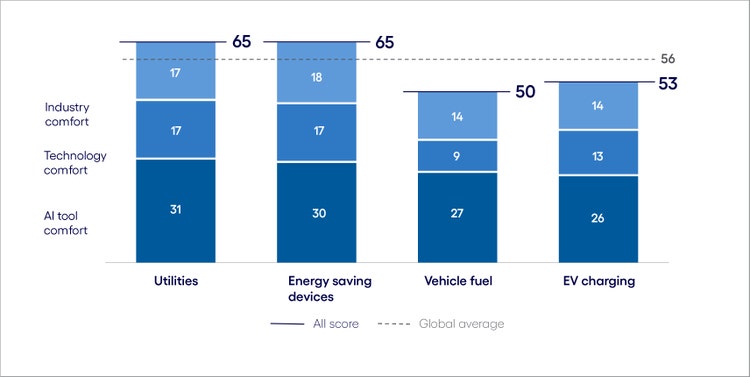
#
<p><span class="small">Figure 4<br> Base: 8,451 respondents in the US, UK, Germany and Australia<br> Source: Cognizant Research</span></p> <p><b>Consumer interest in AI is lowest for vehicle fuel</b></p> <p>Of all the energy and utility product categories, vehicle fuel has the lowest inclination score during Use, at six points below the global average. This is likely because the benefits of using AI in this product category are limited to applications like navigating consumers to the cheapest gas station on their route or making suggestions to alter driving behavior, which is often perceived as unwelcome criticism.</p> <p><b>Privacy concerns counterbalance comfort with technology</b></p> <p>Similar to the Buy phase, consumers’ comfort with AI tools remains high at 30 points,<b> </b>while industry comfort and tech comfort come in at about half that. This shows that consumers are eager to try tools that can help them save time and money but are apprehensive about the context of their use in energy and utilities in the Use phase.</p> <p>This is particularly true for vehicle fuel and charging devices, where many consumers have shared concerns about the potential impact on their privacy, data security and use of their personal data. Such AI systems would base their analysis on information such as location, charging habits and vehicle usage patterns. While this data can optimize fuel efficiency, charging times and vehicle performance, it also raises concerns about privacy breaches, security vulnerabilities and even unfair telematics practices by auto insurers.</p> <p>On the other hand, about <a href="https://www.consumeraffairs.com/finance/smart-home-market-trends.html" target="_blank" rel="noopener noreferrer">43% of US households</a> are estimated to be smart homes this year, reflecting demand for the ability to control lights, appliances, thermostats and more from the palm of your hand. As one consumer said, “AI can help analyze my usage in real-time, allowing me to optimize my consumption and realize cost savings quickly.”</p> <p><b>Older energy and utilities consumers show the lowest AI inclination</b></p> <p>Unlike the trend found in our cross-industry report, where older consumers showed a similar AI inclination as other consumer groups during the Use phase, the opposite is true for energy and utilities. Here, older consumers exhibit significantly less inclination to use AI technologies (with a score of 11) compared with younger consumers aged 18–34, whose average score is 25.</p> <p>One contributing factor could be the overall lower interest among older consumers in purchasing smart-home devices. According to one <a href="https://pro.morningconsult.com/analysis/smart-home-tech-consumer-preferences" target="_blank">study</a>, 47% of older consumers have expressed no interest whatsoever. Their reasons vary: 20% of older consumers feel they do not need these devices, while 11% are simply not seeking this type of technology.</p>
<h4>Meeting consumers where they are in the energy and utilities journey</h4> <p>Consumer use of AI is growing fast, and with it, we’re witnessing the emergence of consumer AI agents. These agents will act like a personal digital concierge, orchestrating complex tasks across the purchase journey.</p> <p>Soon, the internet as we know it today will become the agentic internet: an interconnected ecosystem of AI-enabled tools and agents that autonomously recommend optimal plans, negotiate rates and even switch providers on behalf of the customer. Energy usage will be optimized through predictive analytics and smart device integration, creating a seamless and intelligent experience with minimal human effort.</p> <p>We believe leaders have less than five years to navigate these changes. To prepare for the AI-driven consumer era ahead, energy and utility companies will need to rethink how they operate across these three key areas:</p> <ul> <li><b>Interoperability is key:</b> It is important for energy and utilities companies to ensure that their AI-enabled products and services are discoverable on external AI-driven platforms. As consumer AI agents on the web become more commonplace, utilities must have AI agents ready to interoperate with their consumer counterparts.<br> <br> This will require new infrastructure and data capabilities. Based on our research, consumer preferences show that solar photovoltaic companies as well as those centered around home automation have a lower barrier to entry, while vehicular EV charging companies have more of an uphill challenge to overcome in consumer adoption.</li> </ul> <ul> <li><b>Focus on the customer experience: </b>The nature of energy and utility products and services positions companies to design tools and interfaces that maintain direct engagement with consumers. These may support a wide range of tasks—such as exploring personalized recommendations for energy-saving products, monitoring and controlling energy and utility usage, and paying bills.<br> <br> Lean into conversational AI to facilitate convenience. Consumers show a clear preference for utilizing conversational AI across the purchase journey. This shift signals an evolution in expectations, moving beyond basic chatbot functionalities to more sophisticated interactions, particularly during the Learn and Use phases of the purchase journey, where emphasis on personalized, interactive experiences is key.</li> </ul> <ul> <li><b>Adoption is not one-size-fits-all:</b> Based on consumer preferences, the transition to AI-powered purchase journeys and the agentic internet may feel more intuitive for some than others. Utility and energy companies must account for these differences by designing products and communication strategies that are inclusive across all demographics.<br> <br> Even consumers who are comfortable using AI continue to value human interaction, especially during critical moments. By prioritizing human oversight and accountability in their AI implementations, businesses can build customer experiences that resonate broadly and adapt to a wide range of needs and situations.<br> </li> </ul>
Jump to a section
Introduction #spy-1
AI across the energy and utilities journey #spy-2
subnav- The Learn phase: The pursuit of savings and efficiency drive near-perfect AI index scores#spy-3
subnav- The Buy phase: Consumer interest in AI declines but remains above the global average#spy-4
subnav- The Use phase: Consumers are unexpectedly reserved in AI adoption at the post-purchase stage#spy-5
Meeting consumers where they are in the energy and utilities journey #spy-6
<h5>Authors</h5>





